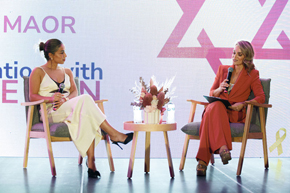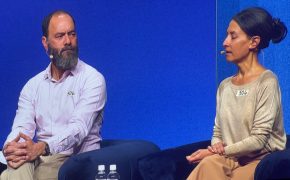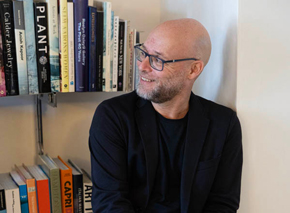From Australia’s Jewish Past
Hyman Herman – geologist and engineer and a leader in all avenues of professional life

Hyman Herman
Hyman was born on 16 August 1875 at Sandhurst in Bendigo, Victoria, the fifth of twelve children to Solomon from Konin, Russia (Poland), and his wife Elizabeth from London. Solomon came to Australia in 1864 and became a respected businessman, land agent, and Jewish spiritual leader of the Bendigo congregation. The family then moved to Perth in 1894.
Hyman grew up amid the Bendigo mining revival; he later claimed that his first interest in geology arose from his boyhood adventures in the abandoned tunnel, which ran under his school. He had a brilliant educational career, helped by scholarships at Gravel Hill (Camp Hill) State School, Sandhurst Corporate High School, and a final year at Scotch College, Melbourne, in 1890. He received his Doctor of Science degree from the University of Melbourne in 1924, having submitted his thesis ‘The Structure of the Bendigo Goldfields’, which Professor Sir Edgeworth David, a geologist, who had led the first expedition to reach the South Magnetic Pole, reported on the thesis as a masterpiece of detailed analysis.
In 1891, Hyman began a four-year engineering course at the University of Melbourne, specialising in mining and metallurgy. He quickly attracted attention, not only for his continuing academic excellence but also as the leader of a successful student protest, against the quality of instruction. Hyman wanted to become a mining engineer, but on completing his course he felt the need for practical experience in geology and so in 1895 joined the Geological Survey of the Victorian Department of Mines and Water Supply. His rise was spectacular. He was nominated as Victoria’s mining representative in Britain, but the Premier of that time, (Sir) George Turner considered Hyman, too young at twenty-three years old. By 1900 he was acting director of the Geological Survey and, through its efforts and his work on the Walhalla goldfields, this helped to reduce the mining industry’s scepticism about the survey’s value. His reputation was acknowledged, yet he confounded his admirers when he declined the directorship of the Victorian Geological Survey at age twenty-nine. Instead, he became an assistant manager with the Mt Bischoff Tin Mining Co. at Waratah, Tasmania. The once-rich mine was in decline, with Hyman rejuvenating it in his four-year stay.
On 2 April 1902 at St Kilda Town Hall. Hyam married Florence and they had three daughters.
In 1907, he established his practice in Queen Street, Melbourne, and for the next five years, he worked across the Australian mining panorama of tin, gold, coal, and copper. He was sought after as a company director, consultant manager, and regular writer for the Australian Mining Standard. He established a reputation for versatility in practice, prudence in counsel, and a nose for snide sampling. He became convinced that gold mining could never be re-established as the staple of Victoria’s economic growth, and perhaps with this in mind, he accepted the position of director of the Geological Survey in 1912. For the next thirty years, he was Victoria’s leading crusader in exploiting her vast brown coal lands.
Hyman’s belief in brown coal was not original, but a legacy from earlier Mines Department geologists. His distinctive contribution was in his professional advocacy and his use of the economic situation during the war years. Imported New South Wales black coal was now tenuous in supply and exorbitant in price; the growing demand for electrical power meant that Victoria’s future rate of industrialisation rested precariously on the need for a cheap, reliable energy source. Hyman brought public opinion behind his cause by manoeuvring an industrial development lobby, the Victorian Institute of New Industries, to press for an inquiry into brown coal use as an energy source. In 1917 he became chairman of a State advisory committee on coal and electricity. The report became the blueprint for the future of Victoria’s power and brown coal industries. It envisaged three major operations: open-cut mining in the La Trobe Valley, the establishment of a large power station and briquette factories (at what was to become Yallourn), and state-wide distribution of electricity. Hyman expected to become the chairman of the newly created State Electricity Commission (SEC), but he was overlooked in 1919, and again in 1931. Instead, he had to be content with the honour in 1920 of becoming its first engineer in charge of brown coal research and briquetting.
Until his retirement in 1940 Hyman searched for new and efficient ways to use brown coal. He helped in the power-station boiler modifications, achieved in the briquette industry profiting by introducing a high-pressure steam system for drying wet coal.
Hyman advised the South Australian Government in 1926 on brown coal mining, prepared the survey of coal resources for the Australian Power Survey in 1928, and was Australia’s representative at the World Power Conference in Washington in 1936. He also headed the Royal Commission into the Western Australian Coal Industry in 1931 and 1933, again displaying his flair in exposing mining scandals.
Following his retirement, Hyman remained a consultant engineer to the SEC for a further fifteen years. His most important task was to convene an inquiry in 1943 into the means of securing Victoria’s total independence from black coal imports, which recommended the expansion of power generation and briquette facilities at Yallourn, hydropower in northern Victoria, and the manufacture of town gas from brown coal. These were all implemented by post-war governments and Hyman lived to see the fulfilment of his dream. He documented much of its application in Victoria and overseas in his comprehensive book Brown Coal published in 1952, which contains a bibliography of his papers on Victoria’s coal resources.
Hyman died on 7 June 1962 in Melbourne. He described his recreations in Who’s Who as ‘many mild ones, not a slave to any’. He had been an accomplished amateur Shakespearian actor, a poet and a horseman; he remained an avid reader, geologist, engineer, company director and mining raconteur. Although regarded as modest, he felt few men were superior to him. He was a leader in all avenues of professional life, whether as sectional president of the Public Service Association, the Chamber of Mines, or the SEC’s Social League. He enjoyed banter that he had imprinted ‘HH’ on household briquettes for personal edification or that he was indeed the ‘father of Yallourn’. As a company employer, he insisted there always be thorough investigation, attention to detail and clarity in reporting. It was noted that he was the only person in the SEC, according to the royal commissioner into its affairs of 1926, who had sufficient breadth of mind and technical ability to understand the entire operation.
Hyman received no civic honours. However, the SEC has renamed its research station at Richmond Victoria the Herman Research Laboratories, in which there is a bronze commemorative plaque. He was also honoured by the Australasian Institute of Mining and Metallurgy, of which he was a councillor for a record sixty-four years, and awarded the institute medal. Yet his greatest honour was to witness the mining and engineering triumphs in the La Trobe Valley. ‘Brown coal in Victoria’, he once stated, ‘has been waiting like a huge fortune in Chancery for the rightful heir to its riches and benefits’. Hyman foresaw its potential and more than any other person harnessed that fortune.
The AJHS acknowledges the following references in the preparation of this story:
Australian Dictionary of Biography – Andrew Spaull; Wikipedia; University of Melbourne Archives; Virtual Yallourn; Encyclopedia of Australian Science and Innovation

The Australian Jewish Historical Society is the keeper of archives from the arrival of the First Fleet in 1788 right up to today. Whether you are searching for an academic resource, an event, a picture or an article, AJHS can help you find that piece of historical material. The AJHS welcomes your contributions to the archives. If you are a descendant of someone of interest with a story to tell, or you have memorabilia that might be of significance for the archives, please make contact via www.ajhs.com.au or stories@ajhs.com.au.







